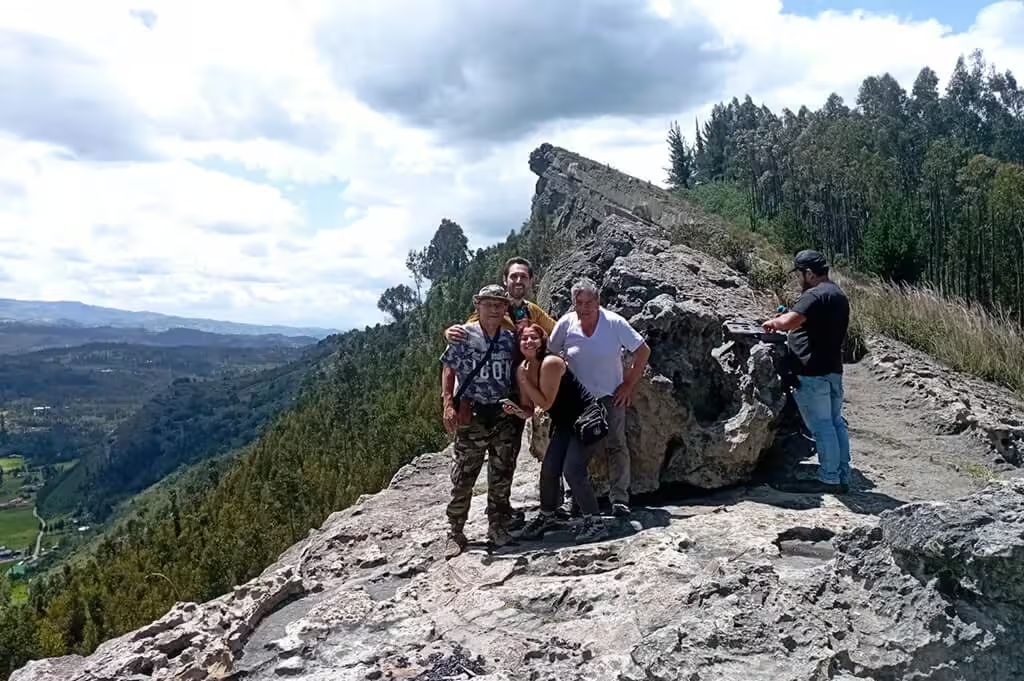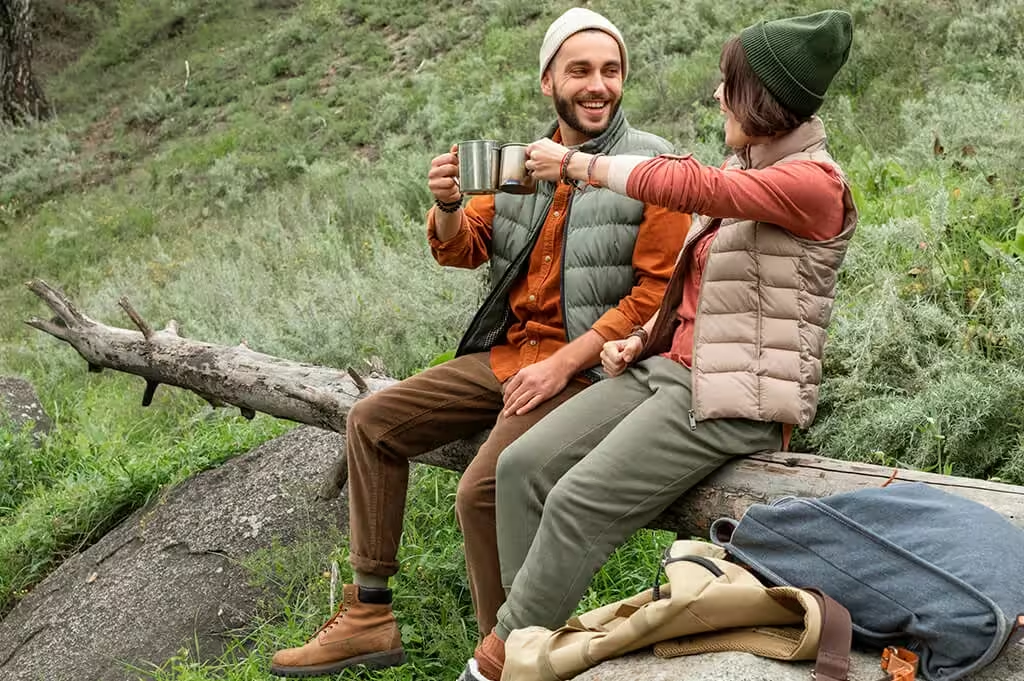
If you love the outdoors and being close to nature, you’ll love hiking the Farallones de Sutatausa.
It’s the perfect plan for two: fresh air, mountain quiet, spectacular views, and a route that evokes ancestral art and history.
These impressive rock formations, stretching for several kilometers, sit very close to Bogotá.
Their main appeal is the mix of rocky ridgelines, beautiful landscapes, and traces of the Muisca culture.
The Farallones de Sutatausa form a rugged ridge that offers majestic panoramas of the Ubaté Valley—right next to a 500-meter drop.
If you’re thinking about taking on this adventure, keep reading this complete guide on how to enjoy a pleasant and safe hike in the Farallones de Sutatausa.
How to Get to the Farallones de Sutatausa
Sutatausa is a small municipality in the department of Cundinamarca, located 85 kilometers north of Bogotá.
Below you’ll find basic, very useful info for your trip to Sutatausa:
How to get to the Farallones de Sutatausa by car
Leaving Bogotá, you can take either the Autopista Norte or Carrera 7 toward La Caro and Chía.
Then follow Route 45A toward Zipaquirá until you reach the bridge that connects to the road to Ubaté (around km 43).
Continue north on Route 45A and you’ll pass a toll called Casablanca on the way to Ubaté.
About 14 kilometers after the toll, on your right, you’ll see a turn-off marked with a sign that says “Farallones de Sutatausa.”
Take that turn; an unpaved but well-maintained road will lead you to your destination.
There’s a parking area where you can confidently leave your car or motorcycle and start the trek.
Depending on traffic, the drive from Bogotá can take between 2 and 2½ hours; most of the route is in very good condition.

How to get to your Farallones de Sutatausa hike by bus
If you’d rather start your adventure without the stress of driving in Bogotá, getting there by bus is easy.
From any of the terminals (North/Salitre/South), there are routes to Ubaté. Transport companies like Rápido El Carmen and Flota Reina run frequent departures throughout the day.
Tell the driver to drop you on the main road in Sutatausa, which is the town just before Ubaté.
From there, it’s easy to find vehicles offering transport up to the Farallones, located in the Novoa rural area (vereda).
The ride usually costs between COP $15,000 and COP $20,000.
Quick Info to Plan Your Farallones de Sutatausa Hike
If you’ve decided to enjoy a stroll with your partner in this beautiful place and take the Ubaté Valley views, keep this in mind:
Distance and duration of the hike
There are several route options, from shorter variants of about 9 km to longer ones around 16 km.
Your time will depend on different factors like pace and route choice. It generally takes 4 to 7 hours.
Altitude
Sutatausa and the lowest part of the Farallones sit at 2,580 m, and some summits reach 3,000 m.
On many public routes, the maximum elevation is around 3,100 m, a great way to feel “high mountain” without going too far.
Route difficulty
Difficulty depends on several factors, including your age, your experience with this type of activity, and trail conditions.
Some sections are rocky with sustained inclines, so take your time and watch your footing.

Highlights of your Farallones hike
The route treats you to gorgeous scenery and viewpoints over the majestic Ubaté Valley.
Along the way, especially if you start near town, you’ll come across rock paintings, a reminder of the region’s rich past.
Best season and weather for the Farallones de Sutatausa
On the high plateau, the most suitable months for hiking are usually December–January and July–August, which tend to be drier.
That said, weather can change quickly, so it’s smart to check IDEAM forecasts so you can dress right, whether it turns into a sunny day or a rainy spell.
Is It Safe to Hike the Farallones de Sutatausa?
The short answer: it depends. Your skill level, experience with this kind of terrain, weather conditions, and whether you’re accompanied play a big role.
Some trails can be tricky and lead to cliffs or steep, exposed areas that may put you at risk.
That’s why it’s very important to have a trained guide, even if you’ve been there before.
The Tourism Office at the Sutatausa mayor’s office works with well-trained guides who know the route and have first-aid skills.
Guides typically include accident insurance and, if needed, the support of a paramedic.
Prices per person can range between COP $45,000 and COP $60,000. For groups, rates can go from COP $140,000 to COP $250,000.

Precautions to keep in mind
Because of the altitude, you might experience mild altitude-sickness symptoms like headache, dizziness, fatigue, nausea, and loss of appetite.
These usually appear 6–24 hours after ascent and tend to go away after some rest.
Even so, take steps to avoid them: hike without rushing, stay hydrated, and avoid alcohol beforehand or during the route.
Sun exposure increases with altitude, so always bring a wide-brim hat, UV-protective sunglasses, and broad-spectrum sunscreen (SPF 15+ or higher).
Also note that rock slabs, wind, and rain can make the hike challenging. If the ground is wet or there’s a storm, skip scrambles and head down.
Finally, some variants cross private or community property.
To avoid awkward situations, stick to marked routes, don’t open fences, and follow your guide’s instructions.
The Farallones de Sutatausa: A Hike That Blends History and Rock Art
One of the most interesting parts of this trek is that, beyond adventure and nature, you’ll be immersed in a place full of ancestral history.
Locals often share a story, part history, part legend, that adds a fascinating layer to your visit.
It’s said that in 1541, tired of Spanish abuses, Muisca people from the Suta, Tausa, and Cucunubá communities sought refuge here.
Under siege by a group of conquistadors and in a desperate act, they threw themselves from the cliff.
Accounts vary on the number of victims: some speak of hundreds, while many versions say around 5,000 people died.
What’s certain is that the episode left a deep mark on the region, turning this place into one that deserves respect for its land and heritage.
Very close to the route you’ll also find the Valle de los Pictogramas, rocks with pictographs that testify to Muisca rock art.

Recommended gear for your Farallones trek
To enjoy the Farallones de Sutatausa hike safely and comfortably, bring:
- Navigation: offline map/GPS and a power bank
- Light: headlamp + spare batteries
- Sun protection: sunglasses, wide-brim hat, sunscreen
- First-aid kit and blister care
- Rain layer and light insulation (layering system)
- Plenty of water and snacks
- Multi-tool/knife
- Fire source (lighter) for emergencies
- Emergency shelter (space blanket)
- Good-grip footwear; trekking poles help on the descents
A Few Tips to Enjoy the Hike as a Couple
You’ll likely enjoy this adventure even more together, altitude feels easier when you walk and chat.
Still, keep your eyes on the trail: some stretches are slick and demand full attention.
Share the load: one backpack with extra water and the first-aid kit; the other with snacks and layers.
Bringing your pet? Keep them on a leash so they don’t wander off.
Where to Stay and Recharge After Your Hike
Staying in Sutatausa makes a real difference: you’ll wake up close to the trailhead and skip traffic.
After your hike in the Farallones de Sutatausa, nothing beats a hot shower, a gentle massage, time in the jacuzzi, and a comforting dinner.
At our hotel, you can wrap up your adventure as a couple in a cozy setting with thoughtful touches that turn the day into a memorable experience.



